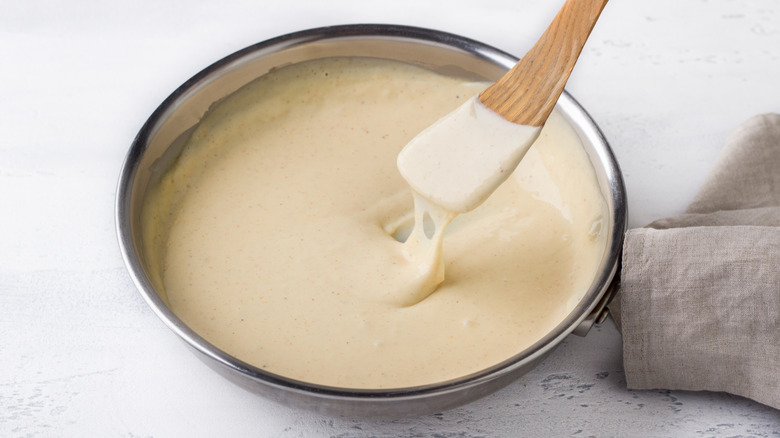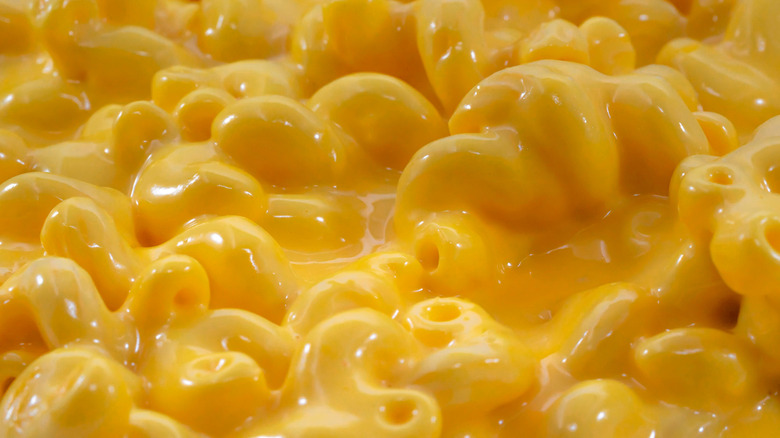Rachael Ray's Secret To Creamy And Smooth Mac And Cheese
It may be time to ditch the blue box, because making mac and cheese from scratch is where it's at. There are tons of recipes online, but celebrity chef Rachael Ray's iteration of this classic dish maximizes the creamy texture. For those who have tried their hand at homemade mac and cheese before, there can sometimes be a struggle in maintaining that perfect texture without the sauce being too runny or grainy. On her YouTube channel, Ray addressed this concern with a straightforward fix.
There are three very important factors, and it all starts with a roux. While you may have seen slow cooker mac and cheese before, and some recipes just involve cheese and milk, making a flour-based roux before adding any cheese is key. The ratios she prescribes are also vital. She includes an extra tablespoon of butter to most recipes. Once it "thickens just to coat the back of a spoon," she adds warm milk, spices, and sometimes stock. For however much liquid there is at this point, she adds an equal amount of shredded cheese a handful at a time. Perhaps the most precarious step is that she avoids overcooking. The moment the cheese is fully incorporated, she takes the sauce off the heat and adds it to the pasta so it doesn't have a chance to get grainy. After that, you can bake your mac and cheese in the oven or serve it up immediately.
Why a roux is important
There's a reason Rachael Ray's first big must with her mac involves making a roux. Besides being the base of several of the five mother sauces of French cooking, roux makes many soups and gravies smoother and more stable. Dating from the 1600s, the recipe for this base remains mostly the same — you need equal parts flour and some sort of fat. Much of the time, and in the case of mac and cheese, you use butter as your fat (and Ray recommends using an extra tablespoon of it for a smoother sauce). When blended together over heat to form a thickened liquid, you get a roux that you can mix with other ingredients, such as milk or cheese.
You may think of flour as something mostly for baking pastries and bread, but the science of it makes sense. The starch in flour swells when it meets moisture, but it needs fat to keep it all from getting clumpy and lumpy. The fat manages to coat each flour particle and lubricates them so they don't stick together, leaving whatever the roux combines with thickened and smooth without a grainy, broken texture. It works for many applications — as long as you regularly stir the mixture and don't let it cook at too high a temperature.
Other ways to upgrade your mac and cheese
If you feel comfortable with the mac and cheese sauce base and are ready to take it to a higher level, there are a few ways you can do so. In some of her recipes, Rachael Ray recommends adding a little mustard or nutmeg to bump up the complexity of flavors. You can also add a touch of horseradish, cayenne, or hot sauce if you want your mac to have some additional kick. If you need a way for kids to eat their veggies, mixing some in works well and makes mac and cheese a more complete one-pan dinner for busy weeknights. Also, consider getting fancy with your cheese choice (as long as you pick something that melts well).
As far as cooking, maybe you like making your mac and cheese as crispy as possible. You can bake it in a casserole dish, but remember to undercook the pasta before it goes in so you get that sought-after al dente mouthfeel. Breadcrumbs are also an easy touch for elevated baked mac, and sourdough provides a surprisingly flavorful crunch. Don't be afraid to experiment, because once you have a smooth, creamy base sauce, like Rachael Ray does, the only limit is your imagination.


